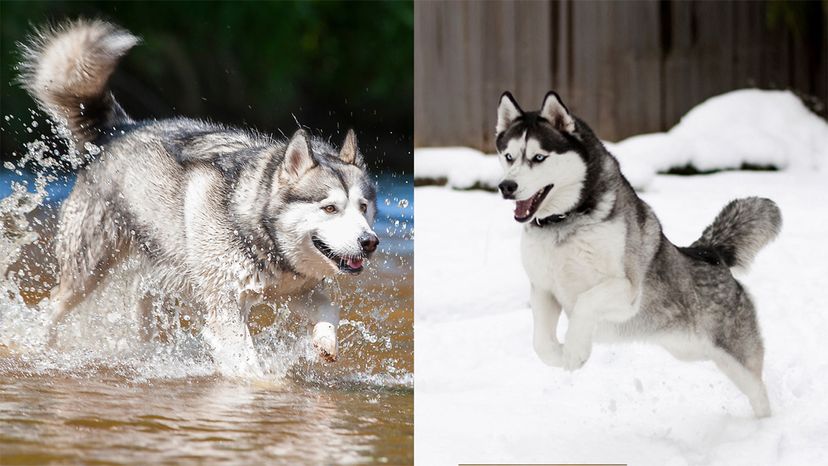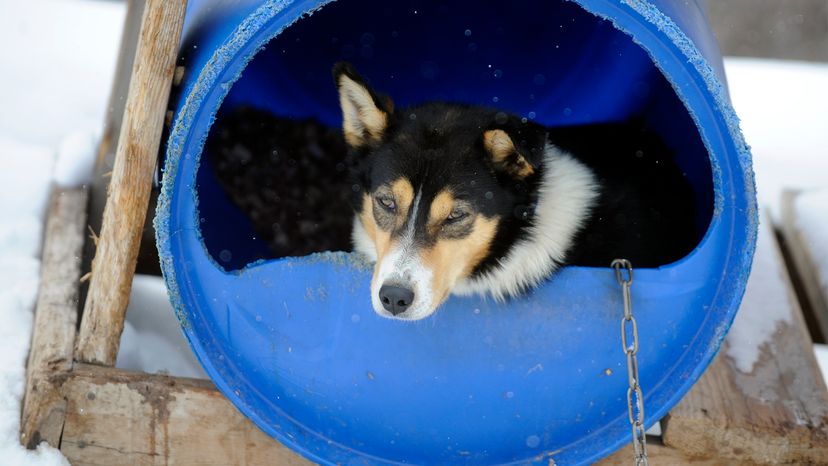 “At left is the Alaskan malamute; at right, the Siberian husky. It’s no wonder that people often get the two mixed up. Malamute: @Hans Surfer-Getty Images. Siberian husky: Claire Baxter//studiofetch.com-Getty Images/HowStuffWorks
“At left is the Alaskan malamute; at right, the Siberian husky. It’s no wonder that people often get the two mixed up. Malamute: @Hans Surfer-Getty Images. Siberian husky: Claire Baxter//studiofetch.com-Getty Images/HowStuffWorks
In the hit HBO television series "Game of Thrones," the children of the royal Stark house are accompanied by dire wolves, which are a sort of impressive wolf-dog hybrid. These dogs don’t exist in the real world — though they did once upon a time in the Ice Age and later became extinct — and the dogs used on the show are actually Northern Inuits.
Nonetheless, prospective dog owners and fans of the TV show are turning in droves to a similar-looking pooch: the Siberian husky. In fact, so many fans are purchasing Siberian huskies that shelters are seeing an uptick in Siberian huskies being abandoned, sadly, likely due to the fact that cute Siberian husky puppies grow up to be hyperactive adults requiring a lot of training and exercise.
But it’s undeniable that the Siberian husky is fast becoming one of the most popular canine breeds. The American Kennel Club (AKC) — an organization that serves as the foremost authority and resource on dog breeds in the U.S. — ranked the Siberian husky as the 12th most popular breed in 2017.
Alaskan Husky vs. Siberian Husky
But did you know that there’s another similar-looking husky, according to some dog lovers? The Alaskan husky — unlike the purebred Siberian husky — is a mix of various Northern dog breeds, so it’s not considered to be its own distinct purebred breed. The Alaskan husky was bred specifically to be a working dog. But what does it mean to be a working dog?
"Quick to learn, dogs of the Working Group are intelligent, strong, watchful, and alert. Bred to assist man, they excel at jobs such as guarding property, pulling sleds and performing water rescues," says Gina DiNardo, executive secretary of the AKC, by email. "They make wonderful companions but because they are large, and naturally protective, prospective owners need to know how to properly train and socialize a dog."
The Alaskan husky is the most commonly used dog in dog sled racing, as they’re known for their tough feet and hardy fur coats that can withstand the chill of winter. It’s more popular in the sled dog trade than even its Siberian counterpart, even though Siberian huskies are also considered working dogs.
However, the Alaskan husky is far from being recognized widely across the world of dog breeders. The AKC does not recognize the Alaskan husky as an official dog breed because it does not meet the organization’s required threshold.
 “This is "Tony," an Alaskan husky sled dog, that took part in the 2009 Iditarod race in Alaska. Alaskan huskies, although not a recognized breed, are often used as working sled dogs.Andy Cross/Getty Images
“This is "Tony," an Alaskan husky sled dog, that took part in the 2009 Iditarod race in Alaska. Alaskan huskies, although not a recognized breed, are often used as working sled dogs.Andy Cross/Getty Images
"To become an AKC recognized breed there must be a minimum number of dogs geographically distributed throughout the U.S., as well as an established breed club of responsible owners and breeders," says DiNardo.
The Alaskan husky sometimes resembles the Siberian husky in terms of appearance, and bothdogs typically weigh between 40 and 60 pounds (18 and 27 kilograms). But the Alaskan husky is usually taller, and because it is a mix of different breeds, its appearance can vary widely.
In the U.S., the Siberian husky is undoubtedly the more well-known of the two dogs, as seen by the number of rescue organizations and breed clubs dedicated specifically to Siberian huskies. By contrast, there are considerably fewer rescues or shelters dedicated to Alaskan huskies, though there are a few that seem open to both Siberian huskies and Alaskan huskies.
Huskies vs. Alaskan Malamutes
But to complicate things even further, there’s ANOTHER dog out there with a very similar name, which also bears a strong resemblance to Siberian huskies. It’s the Alaskan malamute.
Unlike the Alaskan husky, the Alaskan malamute is an officially recognized dog breed according to the American Kennel Club. Like the Siberian husky, the Alaskan malamute is also part of the Working dog group. Alaskan malamutes, alongside Siberian huskies, are also occasionally trained as racing sled dogs. Hence, the two breeds have a number of physical similarities.
"Alaskan Malamutes and Siberian Huskies were both developed as working dogs for cold, snowy climates — hence their thick, double-layer coats consisting of a straight outer coat and dense undercoat," says DiNardo.
They’re also pretty alike when it comes to behavior, training needs and communication. And boy, do they require a lot of dedicated training — and a lot of love. But they also give a lot of love in return.
"Both the Alaskan Malamute and the Siberian Husky are devoted to their owners and friendly dogs," says DiNardo. "They can have an independent nature so both benefit from early socialization and obedience training."
DiNardo offers specific advice for handling both breeds. Alaskan malamutes are adapted to carry heavy loads and thus need daily exercise, says DiNardo. Siberian huskies are well-suited for running and must adhere to a fitness schedule that keeps this factor in mind.
"Romping in a well-fenced yard or other enclosed space will suffice, but Malamutes also enjoy hiking, running, and swimming with their owners," says DiNardo. "Siberian Huskies were bred to run have a desire to run and should have regular exercise on-leash or in a securely fenced-in area."
DiNardo cautions that a failure to properly train or exercise Alaskan malamutes and Siberian huskies will wreak havoc on the well-being of both the owners and the dogs. "Both [breeds] require a job to do and without an outlet for mental and physical energy will resort to bad habits such as chewing and digging to alleviate boredom."
Although it’s easy to confuse Alaskan malamutes and Siberian huskies, there are some notable differences. First, the Alaskan malamute clocks in around 75-85 pounds (34-39 kilograms), whereas the Siberian husky is typically smaller, between 40 and 60 pounds (18 and 27 kilograms), says DiNardo.
But if you’re looking for a sure way to spot the difference between the two breeds, you need look no farther than their tails.
"A Malamute’s pluming tail curls over his back, while a husky’s tail does not curl to either side of the body, nor does it snap flat against the back," says DiNardo.
DiNardo dates the Alaskan malamute’s working dog origins back to Inuit tribes in Alaska, who used the dogs to lug big game by working "in packs to haul heavy loads at low speeds over long distances," says DiNardo. "They were also used for carrying packs in the summer, locating seal breathing holes in the ice, and distracting bears on hunts."
Siberian huskies, on the other hand, can trace their working origins back to the Chukchi people of Northeast Asia and Siberia, who bred Siberian huskies predominantly as light-footed, compact and speedy sled dogs, according to DiNardo.
"In other words, Huskies are racers; Malamutes are freighters," says DiNardo.
State Bans on Malamutes and Huskies
Due to their potentially aggressive behavior and a small handful of high-profile attacks on humans and other canines, both Alaskan malamutes and Siberian huskies are on Bankrate.com’s list of the top 10 dogs that are most frequently blacklisted by insurance companies.
In other words, owning a Siberian husky or an Alaskan malamute may make it more difficult for you to obtain homeowner’s insurance if you live in the U.S. However, some states in the U.S. have pushed back against insurance companies profiling based on dog breed. The fear goes beyond insurance claims: a few cities even have bans or restrictions that designate the dog breeds as "dangerous or vicious." You can see this list to determine whether your city has any restrictions.
A report on fatal dog attacks in Canada between 1990 and 2007 did find a very small number of incidents involving Alaskan malamutes and Siberian huskies. However, dog bites are still pretty rare among these breeds (and dog bite frequency lists have come under criticism from various advocacy groups).
Plus, both malamutes and huskies are recommended for dog owners with families, as they get along well with children. So, if you’re willing to put in the time to care for your dog, there’s no reason why you shouldn’t consider rescuing an Alaskan malamute or a Siberian husky.
If You’re Thinking of Adopting
So, what should you do if you’re interested in adopting either a husky or an Alaskan malamute?
"If someone is looking to rescue an Alaskan malamute or a Siberian husky, the AKC recommends checking the national breed club’s (Alaskan Malamute Club of America/Siberian Husky Club of America) breed-specific rescue first," says DiNardo. "For people looking to purchase a puppy, the AKC recommends finding a reputable and professional breeder to ensure you are getting a happy, healthy pup."
To make your search easier, AKC suggests heading to their online marketplace of breeders, where you can look up a dog based on breed, gender and location. Ask breeders specific questions about the dogs they host and their treatment in the kennels. Do your homework by visiting the breeder’s website and asking them for a reference from another buyer. You could also solicit help from your local kennel club.
But adopting isn’t a one-way street. "Be prepared that the breeder will ask you questions about your life too — as much as you’re vetting them, they are also vetting you as a potential dog owner," says DiNardo.
Now That’s Interesting
One of the most notable differences between Alaskan and Siberian huskies lies in their eye color. Siberian huskies receive world renown for their baby blue eyes, which are linked to a gene mutation on the canine chromosome 18. Siberian huskies can have both blue eyes or a combination of blue and brown eyes. In contrast, most Alaskan huskies have brown eyes.
Originally Published: Oct 28, 2019
Alaskan Malamute FAQs
What is the difference between a husky and malamute?
A major difference between the two is that the malamute tends to have longer hair as compared to the husky. The malamute is also larger than the husky.
How big do Alaskan malamutes get?
Male malamutes stand at 25 inches at the shoulder while females stand at 23 inches high. While males weigh around 85 pounds, female malamutes weigh around 75 pounds.
How much does a giant Alaskan malamute cost?
The average cost of an Alaskan malamute ranges between $1,000 and $6,000. The price varies depending on the malamute breeder.
What is the difference between an Alaskan and Siberian Husky?
Siberians are bigger than Alaskans; Siberians will have blue or a combination of blue and brown eyes while Alaskans usually have brown eyes. Siberian huskies are purebred while Alaskans are mixed breed.
Are malamutes aggressive?
The Alaskan malamute is not considered an aggressive dog. The level of aggressiveness in malamutes mainly depends in the way they are bred.





























